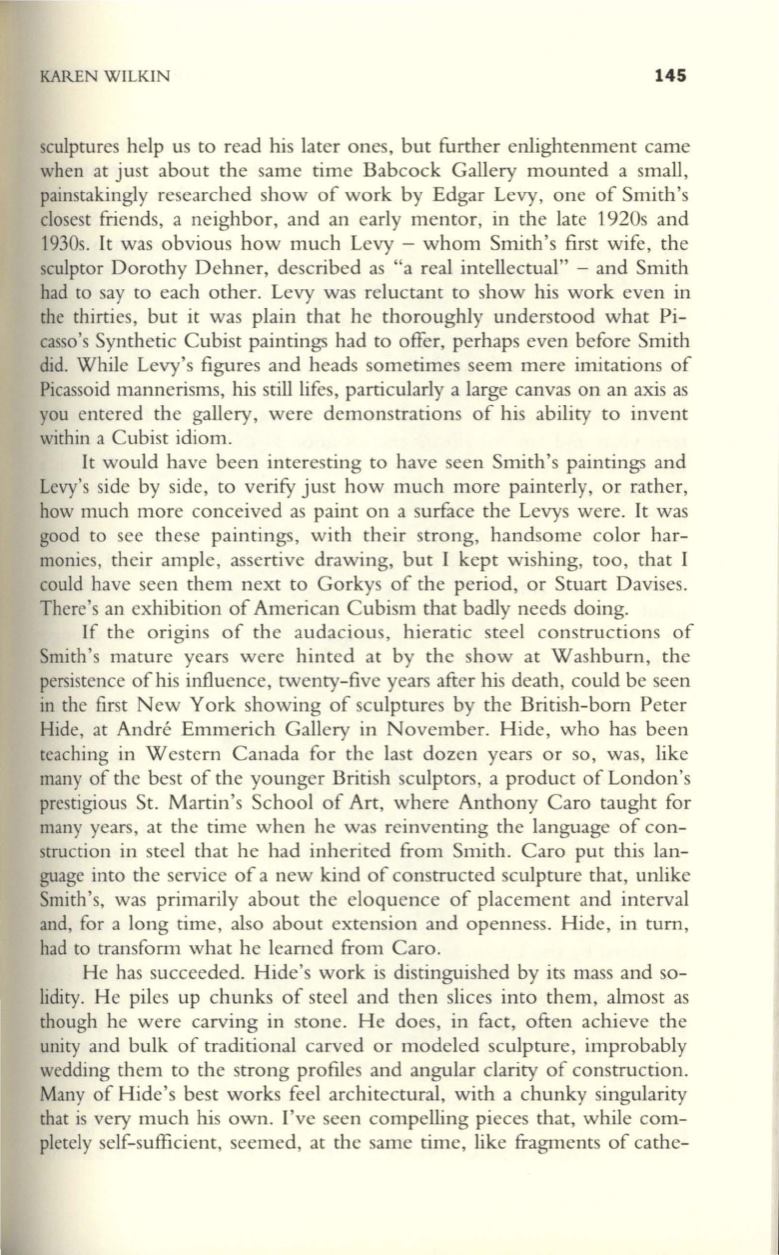
KAREN WILKIN
145
sculptures help us to read his later ones, but further enlightenment came
when at just about the same time Babcock Gallery mounted a small,
painstakingly researched show of work by Edgar Levy, one of Smith's
closest friends , a neighbor, and an early mentor, in the late 1920s and
1930s. It was obvious how much Levy - whom Smith's first wife, the
sculptor Dorothy Dehner, described as "a real intellectual" - and Smith
had to say to each other. Levy was reluctant
to
show his work even in
the thirties , but it was plain that he thoroughly understood what Pi–
casso's Synthetic Cubist paintings had to offer, perhaps even before Smith
did. While Levy's figures and heads sometimes seem mere imitations of
Picassoid mannerisms, his still !ifes, particularly a large canvas on an axis as
you entered the gallery, were demonstrations of his ability to invent
within a Cubist idiom.
It would have been interesting to have seen Smith's paintings and
Levy's side by side, to verify just how much more painterly, or rather,
how much more conceived as paint on a surface the Levys were. It was
good to see these paintings, with their strong, handsome color har–
monies, their ample, assertive drawing, but I kept wishing, too, that I
could have seen them next to Gorkys of the period, or Stuart Davises.
There's an exhibition of American Cubism that badly needs doing.
If the origins of the audacious, hieratic steel constructions of
Smith's mature years were hinted at by the show at Washburn, the
persistence of his influence, twenty-five years after his death, could be seen
in the first New York showing of sculptures by the British-born Peter
Hide, at Andre Emmerich Gallery in November. Hide, who has been
teaching in Western Canada for the last dozen years or so, was, like
many of the best of the younger British sculptors, a product of London's
prestigious St. Martin's School of Art, where Anthony Caro taught for
many years, at the time when he was reinventing the language of con–
struction in steel that he had inherited from Smith. Caro put this lan–
guage into the service of a new kind of constructed sculpture that, unlike
Smith 's, was primarily about the eloquence of placement and interval
and, for a long time, also about extension and openness. Hide, in turn,
had
to
transform what he learned from Caro.
He has succeeded. Hide's work is distinguished by its mass and so–
lidity. He piles up chunks of steel and then slices into them, almost as
though he were carving in stone. He does, in fact, often achieve the
unity and bulk of traditional carved or modeled sculpture, improbably
wedding them to the strong profiles and angular clarity of construction.
Many of Hide's best works feel architectural, with a chunky singularity
that is very much his own. I've seen compelling pieces that, while com–
pletely self-sufficient, seemed, at the same time, !ike fragments of cathe-


